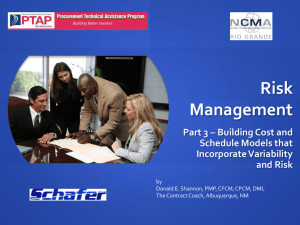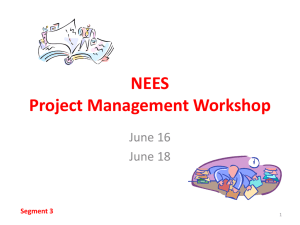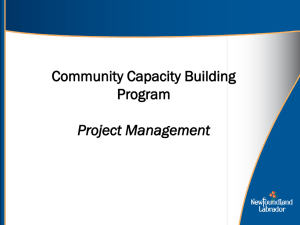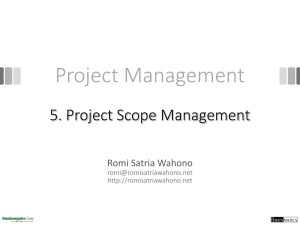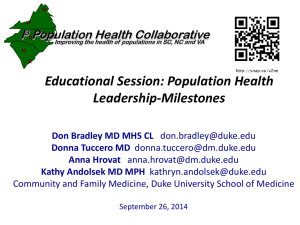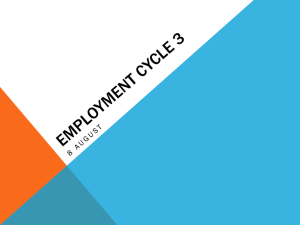What is project management?
advertisement
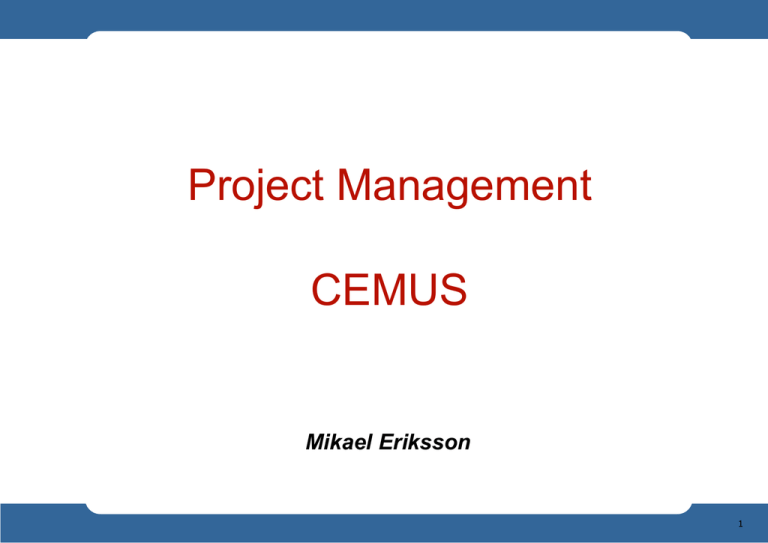
Project Management CEMUS Mikael Eriksson 1 Agenda • What is project management • Terminology • Project models • The project managers most important documents • Project planning 2 What is project management? 3 Team Responsibility Control Organization Limitations Deadlines Software Culture Resource control Risk Expectation Possibilities Goals Education Planning Project Management Reports Specifications Budget follow-up Communication Leadership Milestones Ownership Risk management Time management Priorities Budget 4 A project … Understand Execute and…... Set up an organisation Plan the execution follow up Capture experiences and End 5 ”The Tripple Constraint” Budget Time Technology 6 Planning and communication 7 What is project management? The application of: • • • Knowledge Skills Tools and techniques In order to: • Meet project requirements and expectations 8 Disclaimer!! • Unique, depending on the context • Theory is not enough: skill of craftsmanship is also needed • There is no universal truth… • ”Do not try to reinvent the wheel”: ”stolen with pride!!” 9 The key (to becoming successful) Meet the expectations! 10 The Project manager 11 Some history … 1959 introduced Gaddis the term Project manager Aktivitet A B C D A B D E F Atlas programme C E F G G Tid 1958 PERT 1917 1945 Manhattan project 50’s 1968 1970 1985 Polaris programme 12 Basic terminology 13 Project phases • A project is always divided into phases • Each phase includes activities that have to be executed • Different check points are defined for each phase: Milestone Tollgate Experience shows that such an approach provides a well thought through structure guiding the work to focus on the most important activities, making the final results obtain a high quality 14 Project phases Pre-study Idea Idea Description Use of result Project Specification Project Plan Start Status Report Execution Final Report Closing Tollgate Milestone Project activities that Are always carried out 15 Example PROPS • Phases in PROPS Pre-study phase Feasibility study phase Execution phase Conclusion phase • 5 Tollgates • >8 Milestones 16 Example Vattenfall Project Management Model VPMM model VAR 1 TG0 Purpose with phase TG1 Project Analysis phase VAR 2 TG2 Create an understanding of the feasibility of all realistic solutions Identify a preferred option Identify alternative options PIR VAR 4 TG3 Establishment MS 3 MS 2 VAR 3 TG4 VAR 5 TG5 Project Execution phase Project Planning phase MS 1 FID FTD PIN Identify optimal solution and its scope Ensure sufficient definition of solution and plans to go outside for tendering, contracting and permitting Preparations required for Final Investment Decision Negotiate contracts Define business case within corp. tolerances Analyse risks Obtain critical permits Hand-over MS 5 Realization MS 4 Build what has been designed and fabricated and do so in a controlled and safe way Carry out cold/unit testing and prepare for commissioning Establish and train the organisation which will operate the asset Carry out commissionin g work Ensure that solution is accepted by those who will operate it Hand-over to future asset owner Project Conclusion phase MS 6 Wrap up, evaluate and close out project Plan for PIR 17 Project phases (Ref. PMBOK) 18 The Project Management Body of Knowledge Divided in two parts: • • The knowledge areas of project management Framework for project management 19 The Project Management Body of Knowledge: Knowledge areas Tools and techniques 9 Knowledge Areas Core Functions Scope Mgt. Time Mgt. Cost Mgt. Quality Mgt. Project Integration Management Stakeholders’ needs and expectations HR Mgt. Comm. Mgt. Risk Mgt. Procure. Mgt. Project success Facilitating Functions 20 Roles in a projct 21 The Project manager’s most important documents 22 Project documents Pre-study Idea Idea Description Use of result Project Specification Project Plan Start Progress Report Execution Final Report Closing Tollgate Milestone Project activities that are always carried out 23 The content of the project plan 24 The content of a project plan • Background The aim of this chapter is to inform the reader • • • Why the project has started What has been done prior to the project (pre-study, standardization work, other projects etc.) List of reference documents (For instance course-PM, contract, specifications, etc.) Goals The project group has to agree in a measurable goal for the project Business and project goals What are the ambition of the team members When should the work be delivered Name, address, responsibilities, etc. A table of all phases, milestones, tollgates and responsibilities Organization Project members and other resources connected to the project should be mentioned here Project model (the method you use) The project model refers to which way the project phases have been divided in the planning process Do not forget that you might need to explain the project model in text as well! 25 The content of a project plan • • • Commentary on time and resource plan Explaining text between the diagrams and the project model Risk analysis A short analysis of potential risks that can delay the project, and an action list on how to avoid these risks Document rules How are you going to communicate and take care of documentation • Naming, Reference numbers, Saving, Backup etc. Appendix Time plan Resource plan 26 The Project plan Is the most important document in the entire project Shall make it clear • Why the project is started • How the project will be executed The deliveries WHO is responsible for each delivery and other parts of the project Who are the contact persons surrounding the project • How can the sponsor follow-up the project work I.e. Milestones, measurable goals and deliveries In practice, each new project member shall be able to start work on the project after having read the project plan 27 Example of the content of a status report 1. • • 2. • General description of status What has happened since last report? What is status? Resource status Comment how much of the project resources that has been used and how much that has been delivered. • (In industrial projects, the economical status is reported as well) 3. Problems / Action plan • Problems the sponsor and steering committee need to be aware of 4. Risks / Action plan • Update of the risk analysis • Risks the sponsor and steering committee need to be aware of, and suggestion on how to minimalize them 5. Project changes from the project plan This is where changes are documented so that they become visual. Changes are typically: new requirements, changed requirements, changed organization, changed prerequisites, new documents, etc. Appendix • Updated time plan • Updated resource plan 28 The content of the final report 1. General summary The aim of this paragraph is to describe to the reader how the project was performed • Which results were reached • Differences between the plan (time, budget, result) and the outcome • Discuss the problems that occurred and their effect on the project 2. Goals • Discuss which goals were reached, which were not reached, and explain if there is any work left within the frame of this or sub-sequential project • List of obtained goals • Table of missed requirements and an action plan 3. Experiences and suggested improvements The most important part of the final report. The aim with this paragraph is to analyze and reflect upon the experiences you had during the project and document them thoroughly • 5 ”positive” experiences with the project • 5 ”negative” experiences with the project • What went well and why? • What could have been done better? This paragraph should also consider the experiences that effected the project, such as seminars, tools, sub-contractors, reference groups etc. 29 The content of the final report 4. Summary of time and resource plans Comments to the plans and their milestones and tollgates • Which moments were managed on time? • Which moments were delayed or forgotten in the planning process? • The final versions of the time and resource plan should be attached as appendix 5. Final comment This paragraph can be used by the project manager or project members to provide there own comments or suggestions about the project work. 6. Appendix • Final resource plan • Final time plan 30 The content of a progress report You’re right, the bridge is half finished! Source: Francis Hartman 31 Project planning “If you fail to plan, you plan to fail” 32 The main questions of a project • What should be done? What kind of result should we achieve; scope, extent, content and quality In what form shall it be delivered? • When should it be done? At what point in time should the result be delivered? Are there any sub deliveries? • How should it be done? What approach should we use? Prototypes, COTS, develop from scratch? What processes and methods of work and documentation shall we use? How shall we deliver the result? • Which resources do we have at our disposal? Which are the budget resource constraints? Which are the material resource constraints? Which are the personnel resource constraints? • How do we ensure the right quality? Source: PROMOTE 33 Why is the project start so important? 34 Why is the project start so important? Possibility to change vs. The cost of a change 100% The cost of a change Possibility to change Start Project lifecycle End 35 Planning Two types of planning processes: 1. Backwards planning Is something we always do without reflecting on it 2. Work breakdown structure planning ”Network planning” Follows a structured process 36 Why plan? • The purpose of a plan is to: Define reasonable goals Create strategies on how to achieve the goals Create a shared understanding of the goals and the way to get there Everyone can plan, but the plan must be understood in the same way by everyone in order to avoid problems Create a basis on how to manage and control the project The planning effort should make it possible to manage the future so that the project goals can be achieved 37 “Plans are nothing, planning is everything” Eisenhower 38 Planning In project management there are two types of plans: • Overarching plans or Milestone plans Used outwards to orient people outside the project about the progress Often used in communication with the project sponsor, client or supervisor • Detailed plans or Activity plans Show the activities that must carried through and when they should be performed Often made in a Gantt-schedule 39 Project phases (Source PMBOK) 40 Project planning 1. 2. 3. 4. 5. 6. 7. 8. Formulate the project goal WBS – Work Breakdown Structure Identify tasks Identify dependencies Estimate time Identify the critical path Distribute resources Transfer to Gantt-schedules or other diagrams 41 Simplified planning (no or few parallel activities) 1. 2. 3. 4. 5. Formulate the project goal Divide the project into phases and activities Break down the activities into work tasks Time estimate each work task Schedule and divide the time estimated work tasks on each project participant (resource planning) Step 4 and 6 can you skip if you do not have any parallel activities Step 7 can be done with step 8 42 Project planning 1. 2. 3. 4. 5. 6. 7. 8. Formulate the project goal WBS – Work Breakdown Structure Identify tasks Identify dependencies Estimate time Identify the critical path Distribute resources Transfer to Gantt-schedules or other diagrams 43 Project planning 1. 2. 3. 4. 5. 6. 7. 8. Formulate the project goal Work Breakdown Structure (step 1-PBS) Identify tasks (step 2-WBS) Identify dependencies Estimate time Identify the critical path Distribute resources Transfer to Gantt-schedules or other diagrams 44 How do you eat a whale? 45 WBS - Work Breakdown Structure • • • • Is the most common way to analyze the project in order to achieve a detailed overall picture of the project Can be drawn in from many different perspectives A WBS shall answer the question: What must be done in order to complete the project? It does not answer the question: By who? or... When? 46 WBS • • The more levels, the more detailed information A WBS do not have any relation in time I.e. nothing in the WBS tells you what should be done before anything else • What should be included in the WBS? The deliverable parts I.e. a breakdown of the system, product or service that the project will result in The functional activities and tasks that are needed in order to create and deliver these parts Other functional activities that are needed to manage and administrate the project 47 Project planning 1. 2. 3. 4. 5. 6. 7. 8. Formulate the project goal Work Breakdown Structure – (Step 1 - PBS) Identify tasks – (Step 2 WBS) Identify dependencies Estimate time Identify the critical path Distribute resources Transfer to Gantt-schedules or other diagrams 48 Identify tasks • When you have a WBS with three – four levels, it is time to identify the tasks for each part The level should be at the most a weeks work for one or a few persons in huge projects, and half days work in small projects This identification will also serve as the base for the distribution of tasks within the group • The identification of tasks is also made without any time order It is more important to identify the tasks, than to arrange them in the correct order 49 Relation WBS - PBS WBS Develop a new kind of satellite receiver PBS Construction Market Write work descriptions for the different roles Investigate the market Design a new tuner New prod. line Create a sales team Build a prototype Subcontractors Evaluate the prototype Stock Train the sales team on the new product Plan a sales campaign Production Publish the ad in some technical press Create the advertisement Interview some of the candidates What How Chose candidates for interviews 50 Project planning 1. 2. 3. 4. 5. 6. 7. 8. Formulate the project goal WBS – Work Breakdown Structure Identify tasks Identify dependencies Estimate time Identify the critical path Distribute resources Transfer to Gantt-schedules or other diagrams 51 Post-It method • Requires: En whiteboard Post-It notes Pens • • On the Post-It notes you write the tasks before putting them on the whiteboard, the pens are used to connect the tasks to each other in time Advantage: Everyone can be part of this Easy to change the order 52 Identify dependencies Sometimes called PERT-schedule E Done D A I F C B H G 53 Project planning 1. 2. 3. 4. 5. 6. 7. 8. Formulate the project goal WBS – Work Breakdown Structure Identify tasks Identify dependencies Estimate time Identify the critical path Distribute resources Transfer to Gantt-schedules or other diagrams 54 Estimate time • • Not until all the tasks are identified and related to each other is it possible to make good time estimates Is normally made from the ”bottom-up” Start at the bottom of the WBS Start with estimating the simple tasks and sum up to the bigger tasks 55 Estimate time • To sum up the times of all tasks does not give the total project time Some tasks are made in parallel with several persons and some are related to each other Go back to the PERT diagram and sum up the times for the different paths 56 With time estimates 5 days E 6 days Done D 1 days 1 day 4 days A F 1 day B 2 days C 5 days 5 days I 2 days 3 days G H 2 days 57 Three point estimation • • • Implies that you estimate the most likely time of the tasks Could be done individually or in a group Estimate The longest time for each task (W) The shortest time for each task (B) The mean value of the estimates of each task (N) • Estimated time = (W + 4xN + B)/6 (Always make the three point estimation for the critical path) 58 Project planning 1. 2. 3. 4. 5. 6. 7. 8. Formulate the project goal WBS – Work Breakdown Structure Identify tasks Identify dependencies Estimate time Identify the critical path Distribute resources Transfer to Gantt-schedules or other diagrams 59 Critical path • • When summing up the times for the different paths in the PERT-schedule, the critical path of the project is of special interest The tasks of the critical path must be focused on throughout the project If they are delayed, the project will be delayed • Sum up the shortest and longest three point estimations along the critical path Will give the shortest and longest possible time to conclude the project 60 Critical path B A Critical Path B D A A D E C 61 Identify the critical path 5 days E 6 days Done D 1 days 1 day 4 days A F 1 day B 2 days C 5 days 5 days I 2 days 3 days G H 2 days 62 Project planning 1. 2. 3. 4. 5. 6. 7. 8. Formulate the project goal WBS – Work Breakdown Structure Identify tasks Identify dependencies Estimate time Identify the critical path Distribute resources Transfer to Gantt-schedules or other diagrams 63 Distribute resources The steps to plan the resources of the project 1. Identify the need for resources in each phase and put it in a diagram (x = # persons, y = time) Start from critical path 2. 3. Try to distribute the resources as good as possible Sum up in the resource plan Kritiska linjen Slut Resurser (# personer) Resurser (# personer) Slut 2 7 5 8 3 1 4 Varaktighet (veckor) 6 Kritiska linjen 5 7 2 8 3 1 4 6 Varaktighet (veckor) 64 Task and responsibility contracts • When the tasks are identified, it is time to distribute resources to them Who is responsible for what? Resources can also be rooms, computers and other equipments • A task contract can be a simple table What? Create ads Who? Osquar Starting point Completed working instructions Result in Material for publication 65 Project planning 1. 2. 3. 4. 5. 6. 7. 8. Formulate the project goal WBS – Work Breakdown Structure Identify tasks Identify dependencies Estimate time Identify the critical line Distribute resources Transfer to Gantt-schedules or other diagrams 66 GANTT Activities Time 67 Present situation line Activities Week 9 Time 68 Planning a project according to the Handbook for smaller projects 69 The main questions of a project • What should be done? What kind of result should we achieve; scope, extent, content and quality In what form shall it be delivered? • When should it be done? At what point in time should the result be delivered? Are there any sub deliveries? • How should it be done? What approach should we use? Prototypes, COTS, develop from scratch? What processes and methods of work and documentation shall we use? How shall we deliver the result? • Which resources do we have at our disposal? Which are the budget resource constraints? Which are the material resource constraints? Which are the personnel resource constraints? • How do we ensure the right quality? Source: PROMOTE 70 Summarized in the project plan • • • • • • • • Background Goals Organization This is difficult Project model Comments on time and resource planning Risk Analysis Document rules Appendix Time plan Resource plan This is difficult 71 Simplified planning (no or few parallel activities) 1. Formulate the project goal 2. Divide the project into phases and activities • In what order are we going to do the work? 3. Break down the activities into work tasks • • What are we going to do in each step? Which are the deliveries (i.e. Milestones and Tollgates)? 4. Time estimate each work task • How much time will it take? 5. Schedule and divide the time estimated work tasks on each project participant (resource planning) • Who is spending their time on what task, and when should it be done? 72 Example: Phases to run a course Phases Planning Execution Milestones • Scheduling • Contact lecturers • Develop course material Schedule ready Schedule of lectures ready Available in Bilda • Assignments • Series of lectures Assignments graded Summarizing of series of lectures done Conclusion • Course evaluation • Course end Evaluation ready Final report ready 73 Simplified planning (no or few parallel activities) 1. Formulate the project goal 2. Divide the project into phases and activities • In what order are we going to do the work? 3. Break down the activities into work tasks • • What are we going to do in each step? Which are the deliveries (i.e. Milestones and Tollgates)? 4. Time estimate each work task • How much time will it take? 5. Schedule and divide the time estimated work tasks on each project participant (resource planning) • Who is spending their time on what task, and when should it be done? 74 To chose milestones…… is difficult. • Milestones are the internal points of following up Do NOT put the milestones on deliveries of tasks! Try to place milestones to ensure that you are never late with a delivery without getting indications in advance • Milestones should help you have control on the project 75 To chose tollgates…… is easy • The tollgates are the follow up with the project sponsor or client Often defined in the contract, assignment or methodology of the company Tollgates are evaluations of the projects potential success 76 Break down the phases into tasks • Break down the phases into tasks So the projects tasks become obvious and easy to manage • Chose time unit! Aim on half work days • This means that the project are well thought through early Which is an important side effect of the project planning effort 77 Break down the into phases • Planning of the project Meetings (customer and internal) Meeting with the project sponsor Planning meeting 1 Guidance (inc. preparation) Planning meeting 2 Documentation Examine the project plan • Study of literature Read the suggested books Search the Internet and databases of the library Review the knowledge Write the theory chapter of the Technical report Examine the theory chapter 78 Simplified planning (no or few parallel activities) 1. Formulate the project goal 2. Divide the project into phases and activities • In what order are we going to do the work? 3. Break down the activities into work tasks • • What are we going to do in each step? Which are the deliveries (i.e. Milestones and Tollgates)? 4. Time estimate each work task • How much time will it take? 5. Schedule and divide the time estimated work tasks on each project participant (resource planning) • Who is spending their time on what task, and when should it be done? 79 Break down the phases and estimate the time • Planning of the project Meetings (customer and internal) Meeting with the project sponsor Planning meeting 1 Guidance (inc. preparation Planning meeting 2 Documentation Examine the project plan x * 8 hours x * 4 hours x * 4 hours x * 4 hours x * 4 hours y * 4 hours z * 2 hours • Study of literature Read the suggested books Search the Internet and databases of the library Review the knowledge Write the theory chapter of the Technical report Examine the theory chapter y * 12 hours z * 8 hours x * 4 hours z * 8 hours y * 2 hours Sum up the time 80 Simplified planning (no or few parallel activities) 1. Formulate the project goal 2. Divide the project into phases and activities • In what order are we going to do the work? 3. Break down the activities into work tasks • • What are we going to do in each step? Which are the deliveries (i.e. Milestones and Tollgates)? 4. Time estimate each work task • How much time will it take? 5. Schedule and divide the time estimated work tasks on each project participant (resource planning) • Who is spending their time on what task, and when should it be done? 81 Break down the phases and estimate the time • Planning of the project Meetings (customer and internal) Meeting with the project sponsor Planning meeting 1 Guidance (inc. preparation Planning meeting 2 Documentation Examine the project plan • Study of literature Read the suggested books Search the Internet and databases of the library Review the knowledge Write the theory chapter of the Technical report Examine the theory chapter Joakim x * 8 hours (Joakim) x * 4 hours (Mårten) x * 4 hours (Pia) x * 4 hours (Joakim) x * 4 hours (Joakim) y * 4 hours (Mårten) z * 2 hours (Joakim) Mårten y * 12 hours (Mårten) z * 8 hours (Pia) x * 4 hours (Joakim) z * 8 hours (Pia) y * 2 hours (Joakim) Sum up the time 82 Example of the phases (project model) Project phase Milestones Planning Project plan done Tollgates Ready date Responsible 2004-10-29 Oskar 2004-11-05 Alfred Purchase done 2004-12-09 Bjarne Appetizer done 2004-12-10 Tina 2004-12-10 Alfred Purchase done 2004-12-08 Bjarne Main course done 2004-12-10 Oskar 2004-12-10 Alfred Purchase done 2004-12-01 Bjarne Dessert done 2004-12-03 Oskar 2004-12-06 Alfred Project plan approved Appetizer Appetizer approved to serve Main Course Main course approved to serve Dessert Dessert approved to serve Snacks Purchase done 2004-11-20 Bjarne Beverage Purchase done 2004-11-03 Frithiof 2004-11-10 Alfred 2004-12-17 Oskar 2004-12-23 Alfred Beverage approved to serve Closing Final report done Final report approved 83 Milestone diagram (or time plan) År :2003 Vecka10 11 12 13 14 15 16 17 18 19 20 21 22 23 24 25 26 27 28 29 30 31 32 33 34 35 36 37 38 39 40 41 42 43 44 45 46 47 Uppdaterad Projektnamn: Projektledare Projektkod Datum Milstolpar / Bevakningspunkter 1 5 9 2 6 10 3 7 11 4 8 12 84 Milestone diagram (or time plan) År :2003 Vecka10 11 12 13 14 15 16 17 18 19 20 21 22 23 24 25 26 27 28 29 30 31 32 33 34 35 36 37 38 39 40 41 42 43 44 45 46 47 Uppdaterad 1 Projektnamn: 2 m 2003-03-08 m 3 5 6 7 m mmm 9 10 11 mmm Milstolpar / Bevakningspunkter 2C1222 Projektstyrning1 Schemaläggning 5 Föreläsningsserien 9 Inlämningsuppgift 1 13 Projektledare 2 Kontakta föreläsare 6 Inlämningsuppgift 4 10 14 Kursutvärdering/slutrapport Joakim Lilliesköld 3 Kursmaterial på tryck 7 Inlämningsuppgift 2 11 Kursavslut Projektkod 4 Inlämningsuppgift 3 8 Inlämningsuppgift 5 12 Datum 15 16 2C1222 2003-05-01 85 Milestone diagram (or time plan) År :2003 Vecka 10 11 12 13 14 15 16 17 18 19 20 21 22 23 24 25 26 27 28 29 30 31 32 33 34 35 36 37 38 39 40 41 42 43 44 45 46 47 Uppdaterad 1 2 3 5 6 7 9 10 11 2003-03-08 m m m mmm mm 2003-05-03 l m m mmm mm m mmm mm 2003-08-02 mm mmm mm 2003-08-16 m mmm mm 2003-08-23 l mmm mm mmm mm m 2003-06-16 l 2003-09-01 Projektnamn: Milstolpar / Bevakningspunkter 2C1222 Projektstyrning 1 Schemaläggning 5 Föreläsningsserien 9 Inlämningsuppgift 1 Kursutvärdering/slutrapport 14 Projektledare 2 Kontakta föreläsare 6 Inlämningsuppgift 4 10 Joakim Lilliesköld 3 Kursmaterial på tryck 7 Inlämningsuppgift 2 11 Projektkod Datum 4 Inlämningsuppgift 3 8 Inlämningsuppgift 5 12 2C1222 2003-09-01 Kursavslut 13 15 16 86 Coverage and resource plan Personal Vecka Utfall Planerat Utfall Planerat Utfall Planerat Utfall Planerat Utfall Planerat Utfall Planerat Utfall Planerat 35 36 37 38 39 40 41 42 43 44 45 46 47 48 49 50 51 52 53 1 2 3 4 5 6 35 36 37 38 39 40 41 42 43 44 45 46 47 48 49 50 51 52 53 1 2 3 4 5 6 7 8 9 10 11 12 13 14 15 16 17 18 19 20 21 22 23 24 (h) (h) (h) (h) (h) (h) (h) (h) (h) (h) (h) (h) (h) (h) Tid Detta skall framgå i diagrammet Kalkylerad tid 800 Planerat arbete Upparbetat x Uppskattat slutresultat 600 400 Projektnamn: 200 Projektedare 7 8 9 10 11 12 13 14 15 16 17 18 19 20 21 22 23 24 87 Coverage and resource plan Personal Vecka 35 Utfall Planerat Utfall Planerat Utfall Planerat Utfall Planerat Utfall Planerat Utfall Planerat Utfall Oskar Bjarne Tina Alfred Frithiof Planerat 36 37 38 39 40 41 42 43 (h) (h) (h) (h) (h) (h) (h) (h) (h) (h) (h) (h) (h) (h) 44 45 40 10 46 47 48 20 49 50 51 40 40 10 40 40 20 40 20 10 10 20 20 44 45 46 52 53 20 40 10 Tid 500 X Detta skall framgå i diagrammet 400 x Kalkylerad tid Planerat arbete Upparbetat Uppskattat slutresultat 300 200 Projektnamn: 100 Projektedare 35 36 37 38 39 40 41 42 43 47 48 49 50 51 52 53 88 Coverage and resource plan Personal Vecka 35 Utfall Planerat Utfall Planerat Utfall Planerat Utfall Planerat Utfall Planerat Utfall Planerat Utfall Oskar Bjarne Tina Alfred Frithiof Planerat 36 37 38 39 40 41 42 43 (h) (h) (h) (h) (h) (h) (h) (h) (h) (h) (h) (h) (h) (h) 44 30 40 10 20 10 20 10 10 45 10 10 46 47 48 49 40 40 40 40 50 51 40 10 53 40 40 10 20 10 20 52 10 10 10 20 20 40 10 Tid 500 X Detta skall framgå i diagrammet 400 x X Kalkylerad tid Planerat arbete Upparbetat Uppskattat slutresultat X 300 200 Projektnamn: 100 Projektedare 35 36 37 38 39 40 41 42 43 44 45 46 47 48 49 50 51 52 53 89 Words of wisdom ”Mistakes are the only thing you know for sure that you will make” ”You will not make the same mistake two times, rather you will make it three- four times” Bengt Ekenstierna 90



